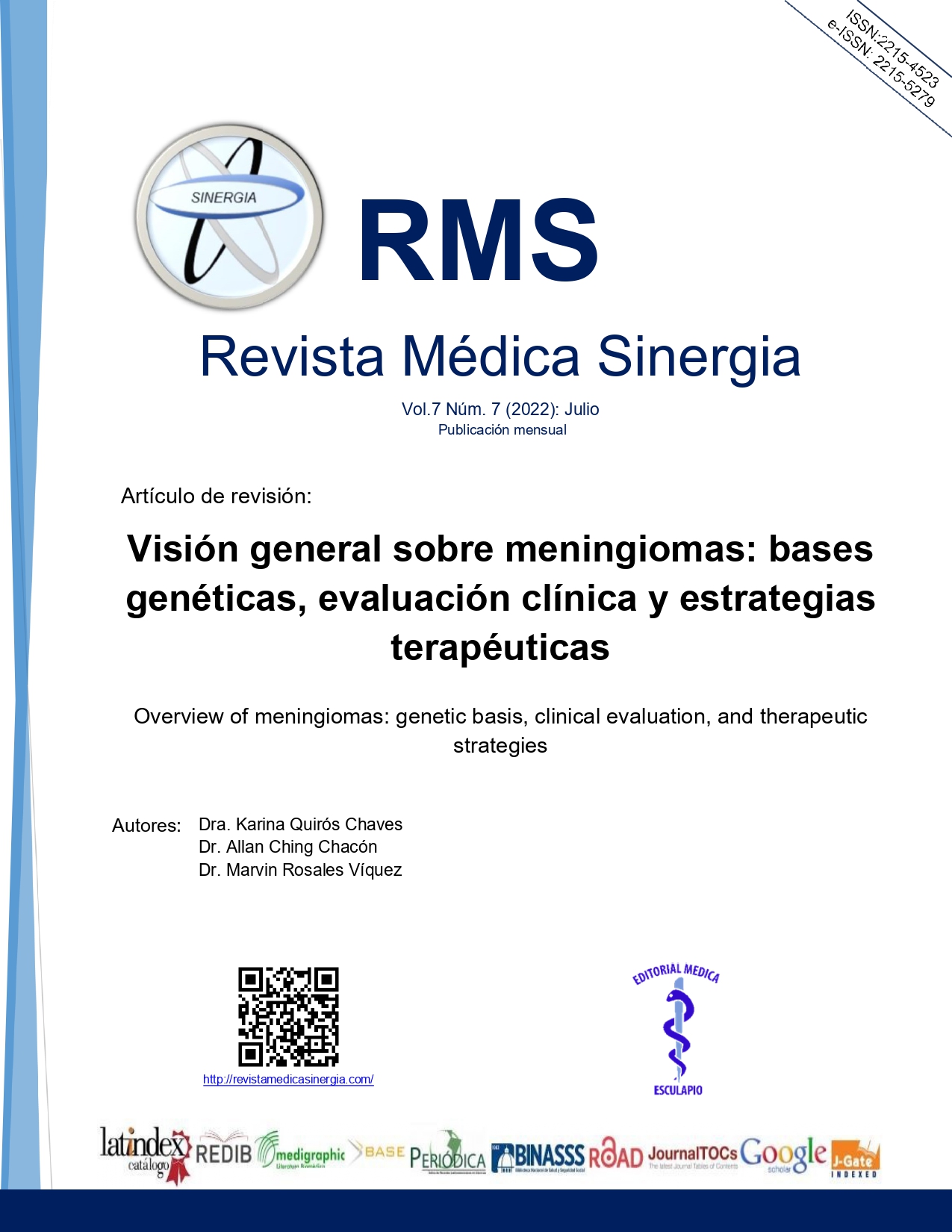Abstract
Meningiomas are the most common primary intracranial tumor of the central nervous system. For the most part, they´re benign, appearing typically in adulthood and the female population. Meningiomas arise from meningothelial (arachnoid) cells, with tendency locate at the level of the skull´s base. The World Health Organization classification for meningiomas, commonly known as “WHO” classification, represents a fundamental tool for determining prognosis, recurrence rate, and decision-making, regarding the overall management of these patients. This classification is based on the histopathological characteristics of the tumor, classifying them into three grades; the greater the Grade, the fewer therapeutic options and less favorable outcome. A series of molecular profiles and genetic aberrations have been correlated with these degrees; allowing stratification based on cytogenetic findings. However, these profiles have yet to be considered in the latest update of the classification. Definitive diagnosis is based on histopathology, but initially magnetic resonance imaging (MRI) represents the study of choice for identification and follow-up of meningiomas. The clinical presentation of meningiomas is often non-specific, and the physical exam tends to be unremarkable in most cases. Treatment for meningiomas is essentially determined by the meningiomas grade and is highly individualized. It includes a combination of observation, surgical resection, and radiotherapy (RT). Prognosis is predominantly determined by gross total resection and histopathology. The Simpson Grade System, correlates these elements in order to estimate the rate of recurrence after surgery. Advances in fields such as neuroimaging, radiology and neurosurgery; have allowed a higher degree of gross total resection to be achieved, improving the prognosis and survival rates of these patients. This review provides an overview of the genetic basis, general evaluation, and treatment for these tumors.
Keywords
References
Pérez Castro y Vázquez Jorge Alfonso, Díaz Echevarria Alfonso, Barrios Calyecac Diana Yolatl, Lara Moctezuma Lizbeth. Presentación de un meningioma con síntomas iniciales oftalmológicos. Rev. Fac. Med. (Méx.) [Internet]. Octubre del 2018. [Citado el 27 de abril del 2022 ] ; 61( 5 ): 32-43. Disponible en: http://www.scielo.org.mx/scielo.php?script=sci_arttext&pid=S0026-17422018000500032&lng=es
Ogasawara, C.; Philbrick, B.D.; Adamson, D.C. Meningioma: A Review of Epidemiology, Pathology, Diagnosis, Treatment, and Future Directions. Biomedicines 2021.[Internet]. [Citado el 5 de abril del 22] Disponible en: https://doi.org/10.3390/ biomedicines9030319
K Park. MD, PhD. Epidemiology, Pathology, clinical features, and diagnosis of meningioma. Post TW, ed. UpToDate. Waltham, MA: UpToDate Inc. [Internet] Junio del 2022. [Citado el 24 de abril del 2022 ] Disponible en: https://www.uptodate.com/contents/epidemiology-pathology-clinical-features-and-diagnosis-of-meningioma
Goldbrunner R, Stavrinou P, Jenkinson MD, Sahm F, Mawrin C, Weber DC, et al. EANO guideline on the diagnosis and management of meningiomas. Neuro Oncol [Internet]. 2021[Citado el 3 de mayo del 22];23(11):1821–34. Disponible de: http://dx.doi.org/10.1093/neuonc/noab150
Buerki RA, Horbinski CM, Kruser T, Horowitz PM, James CD, Lukas RV. An overview of meningiomas. Future Oncol [Internet]. 2018[Citado el 20 de abril del 22];14(21):2161–77. Disponible en: http://dx.doi.org/10.2217/fon-2018-0006
Álvarez Pinzón AM. Evaluación clínica de meningioma intraventricular: reporte de caso paciente pediátrico y paciente adulto. Rev Med [Internet]. 2017 [Citado el 24 de abril del 22];25(1):78–86. Disponible en: http://dx.doi.org/10.18359/rmed.2923
DiGiorgio AM, Virk MS, Mummaneni PV. Spinal meningiomas. Handb Clin Neurol [Internet]. 2020 [Citado el 24 de abril del 22];170:251–6. Disponible en: http://dx.doi.org/10.1016/B978-0-12-822198-3.00045-8
Nowosielski M, Galldiks N, Iglseder S, Kickingereder P, von Deimling A, Bendszus M, et al. Diagnostic challenges in meningioma. Neuro Oncol [Internet]. 2017 [Citado el 1 de abril del 22];19(12):1588–98. Disponible de: http://dx.doi.org/10.1093/neuonc/nox101
Lee YS, Lee YS. Molecular characteristics of meningiomas. J Pathol Transl Med [Internet]. 2020 [Citado el 2 de mayo del 22].;54(1):45–63. Disponible en: http://dx.doi.org/10.4132/jptm.2019.11.05
Helen A Shih, MS, MPHJohn K Park, MD, PhD. Management of atypical and malignant (WHO Grade 2 and 3) meningioma.UpToDate, Post, TW (Ed), UpToDate, Waltham, MA, 2021. [Internet]. 1 de Octubre del 2021 [Citado el 1 de abril del 22]. Disponible en : https://www.uptodate.com/contents/management-of-atypical-and-malignant-who-grade-2-and-3-meningioma
Eric T Wong, Julian K Wu, Overview of the clinical features and diagnosis of braintumors in adults. UpToDate, Post, TW (Ed), UpToDate, Waltham, MA, 2020.[Internet]. 7 de Diciembre del 2021.[Citado el 29 abril del 22).Disponible en: https://www.uptodate.com/contents/overview-of-the-clinical-features-and-diagnosis-of-brain-tumors-in-adults
Apostolov G, Kehayov I, Kitov B. Clinical aspects of spinal meningiomas: A review. Folia Med (Plovdiv) [Internet]. 2021[Citado el 2 de mayo del 22].;63(1):24–9. Obtenido de: http://dx.doi.org/10.3897/folmed.63.e52967
Pinzi V, Bisogno I, Prada F, Ciusani E, Fariselli L. Radiotherapy of meningioma: a treatment in need of radiobiological research. Int J Radiat Biol [Internet]. 2018[Citado el 2 de mayo del 22];94(7):621–7. Disponible en: http://dx.doi.org/10.1080/09553002.2018.1478157
John K Park, Helen A Shih. Management of known or presumed benign (WHO grade 1) meningioma. UpToDate, Post, TW (Ed), UpToDate Waltham, MA, 2021.[Internet] [Citado el 1 de abril del 22]. Disponible en: https://www.uptodate.com/contents/management-of-known-or-presumed-benign-who-grade-1-meningioma
Pikis S, Bunevicius A, Sheehan J. Outcomes from treatment of asymptomatic skull base meningioma with stereotactic radiosurgery. Acta Neurochir (Wien) [Internet]. 2021[Citado el 3 de mayo del 22];163(1):83–8. Disponible en: http://dx.doi.org/10.1007/s00701-020-04648-4
Ajler P, Beltrame S, Massa D, Tramontano J, Baccanelli M, Yampolsky C. Relevancia de los grados de Simpson en la resección de meningiomas grado I: Relevance of Simpson’s grades in the resection of grade I meningiomas. Surg Neurol Int [Internet]. 2017;8(3):5. [Citado el 2 de mayo del 22]. Disponible en : http://dx.doi.org/10.4103/sni.sni_84_17
Rae-Grant A, Erlich Alan MD. Meningiomas, Complications and Prognosis. EBSCO Information Services, Dynamed. [Internet]. Junio 2021[Citado el 4 de mayo del 22]. Disponible en: https://www.dynamed.com/condition/meningioma

This work is licensed under a Creative Commons Attribution-NonCommercial 4.0 International License.
Copyright (c) 2022 Array


